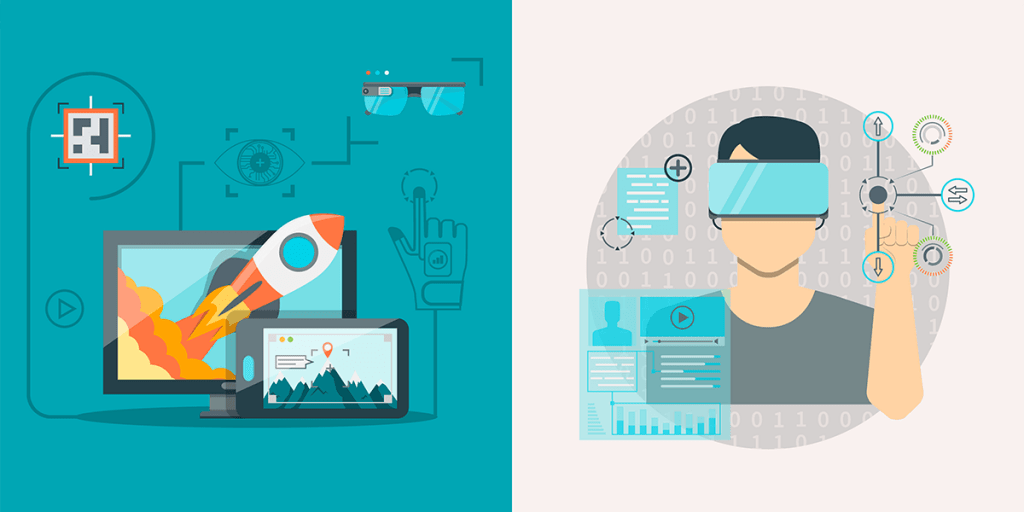In the realm of technology and innovation, augmented reality (AR) and virtual reality (VR) have emerged as two groundbreaking technologies that are transforming the way we experience and interact with the digital world. While they may seem similar at first glance, AR and VR offer distinct experiences and serve different purposes. In this article, we will delve into the world of AR and VR, exploring their definitions, applications, and the key differences that set them apart.
What is Augmented Reality (AR)?
Augmented Reality is a technology that overlays digital information or virtual content onto the real world, enhancing our perception and interaction with the environment. AR integrates virtual elements seamlessly into the user’s real-world surroundings, creating an immersive and interactive experience. It does this by leveraging cameras, sensors, and other input devices to track the user’s position and superimpose computer-generated graphics or information onto the real-world view.
Unlike VR, which creates a completely virtual environment, AR enhances and augments the existing physical world by adding digital elements such as 3D models, text, videos, or animations. This technology has found applications in various fields, including gaming, education, retail, healthcare, and industrial sectors.
Virtual Reality (VR): Immersion into a Virtual World
Virtual Reality, on the other hand, transports users into a fully simulated and immersive virtual environment that is separate from the real world. Through the use of headsets or goggles, users are completely immersed in a computer-generated environment that can replicate real-life scenarios or create entirely fictional worlds.
VR aims to provide users with a sense of presence, making them feel as if they are physically present in the virtual environment. By blocking out the real world and stimulating the user’s senses through visuals, sounds, and sometimes even haptic feedback, VR offers a highly immersive experience that can be utilized in gaming, training simulations, virtual tours, and other applications.
The Key Differences between AR and VR:
- Immersion Level: While both AR and VR provide immersive experiences, the level of immersion differs. VR fully replaces the real-world environment, transporting users to a virtual realm. AR, on the other hand, overlays virtual elements onto the real world, allowing users to interact with both digital and physical objects simultaneously.
- Interaction with the Real World: AR integrates digital content with the real world, enhancing our perception and interaction with the environment. Users can see and interact with real-world objects while also accessing additional information or virtual elements. VR, in contrast, isolates users from the real world, creating a fully virtual experience where interaction is limited to the virtual environment.
- Applications and Use Cases: AR and VR have distinct applications and use cases. AR finds practical applications in industries such as retail, healthcare, education, and navigation, where real-time information and interactive experiences are crucial. VR, on the other hand, is widely used in gaming, entertainment, training, and simulation environments where a fully immersive virtual experience is desired.
- Hardware Requirements: The hardware requirements for AR and VR differ. AR can be experienced through various devices such as smartphones, tablets, smart glasses, or headsets equipped with cameras and sensors. VR typically requires more advanced hardware, including high-resolution headsets, motion controllers, and in some cases, powerful computers or gaming consoles.
Common Examples Of Augmented Reality
- Retail and E-commerce: AR is transforming the way consumers shop by allowing them to virtually try on clothing, accessories, or cosmetics before making a purchase. For example, AR-enabled apps let users see how furniture would look in their homes or try different paint colors on their walls.
- Gaming and Entertainment: AR has had a significant impact on gaming and entertainment. Games like Pokémon Go brought AR into the mainstream, allowing players to interact with virtual creatures in real-world environments. AR is also used in live events and concerts to enhance the audience’s experience with immersive digital elements.
- Education and Training: AR is revolutionizing education by creating interactive and engaging learning experiences. It can overlay 3D models, animations, or additional information onto textbooks or real-world objects, providing students with a deeper understanding of complex subjects. AR is also used for training simulations in industries like aviation, medicine, and military.
- Navigation and Wayfinding: AR is being utilized for enhanced navigation experiences. Apps provide real-time directions by overlaying digital arrows or markers onto the user’s real-world view, guiding them to their destination. This technology can be particularly useful for exploring new cities or finding points of interest.
- Healthcare and Medical Training: AR is making advancements in healthcare by aiding in surgical procedures and medical training. Surgeons can use AR headsets to visualize patient data, overlaying it onto the surgical field to improve accuracy. Medical students can also benefit from AR simulations to practice complex procedures in a controlled environment.
- Manufacturing and Maintenance: AR is being employed in manufacturing and maintenance processes to assist workers. By wearing AR-enabled devices, technicians can access real-time instructions, diagrams, or troubleshooting information overlaid on machinery, simplifying complex tasks and reducing errors.
- Tourism and Cultural Heritage: AR enhances the tourism experience by providing virtual guides and interactive information at historical sites or museums. Users can point their smartphones at landmarks to access historical facts, stories, or reconstructions of ancient structures, bringing history to life.
These examples illustrate the diverse range of applications for augmented reality across industries. As AR technology continues to advance, we can expect to see even more innovative and practical uses that enhance our daily lives and transform various sectors of society.
Play-to-earn A.R. and V.R.
Play-to-earn games exist in both augmented reality (AR) and virtual reality (VR) environments. Examples include Axie Infinity, where players breed and battle virtual creatures to earn rewards, Decentraland, a VR platform where users can create and monetize virtual worlds, The Sandbox, where players can design and sell digital assets using blockchain, and CryptoKitties, a blockchain-based game for collecting and trading virtual cats. These games utilize blockchain technology and cryptocurrencies, allowing players to earn valuable in-game assets that can be traded or sold for real-world value. Players can convert their earnings into stablecoins, which are cryptocurrencies pegged to the value of a stable asset like the US dollar, providing stability and a means to store value. This allows players to participate in the play-to-earn economy while having the option to convert their earnings to more stable digital assets.
How To Exchange Play-to-earn Profits Converted to Stablecoins For Fiat Here At DartAfrica
At DartAfrica, we offer a convenient and advantageous solution for converting your cryptocurrency to fiat and withdrawing it to your local bank account instantly. Our innovative cryptocurrency trading platform focuses on providing a pleasant and hassle-free experience for users in Ghana and Nigeria who want to sell cryptocurrencies for fiat. We provide exceptional customer support and facilitate the exchange of popular cryptocurrencies like USDT, USDC, ETH, and BTC, with plans to expand our selection to cater to diverse consumer preferences. One significant advantage of using DartAfrica is that we have no transaction fees, setting us apart from other exchange platforms and traditional banking institutions. Our user-friendly platform ensures a simple and secure transaction process. To get started with DartAfrica:
- Visit our website and complete a quick registration.
- Create a transaction pin for secure withdrawals by accessing your account settings and selecting “Security.”
- For instructions on setting up a local bank account, refer to the “Account Details” section.
- When you’re ready to deposit, choose the desired coin by clicking “Sell Coins” and enter the USD amount (minimum $20). Upon selecting “Sell Now,” you will receive a QR Code and wallet address to deposit the equivalent amount of cryptocurrency.
- After two block confirmations, the corresponding fiat amount will be transferred to your account. You can track the progress of your transaction in the “Trades” area and monitor it on your dashboard.
- To withdraw funds to your pre-established bank account from step 3, click “Withdraw funds” and enter the desired amount. Enjoy the convenience of quick credit to your local bank account without any additional fees.
By utilizing DartAfrica’s services, you can seamlessly and efficiently exchange cryptocurrency for fiat. Our user-friendly platform, swift transactions, and absence of transaction fees make the process highly advantageous. Experience the convenience and reliability of DartAfrica for all your crypto-to-fiat conversions.
A good way to wrap this up would be to understand that augmented reality (AR) and virtual reality (VR) are two transformative technologies that offer unique experiences and have distinct applications. AR overlays digital content onto the real world, enhancing our perception and interaction with the environment. VR, on the other hand, immerses users in a fully simulated virtual environment.
Both AR and VR hold immense potential across various industries, revolutionizing fields such as gaming, education, healthcare, retail, and beyond. By understanding the differences between AR and VR, we can better appreciate their capabilities and explore the possibilities they present in shaping the future of technology and human interaction.
As technology continues to advance, AR and VR are expected to evolve further, blurring the lines between the real and virtual worlds, and unlocking new possibilities for immersive experiences and innovative applications.





